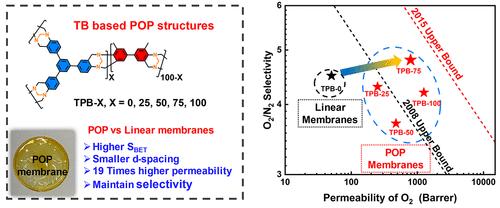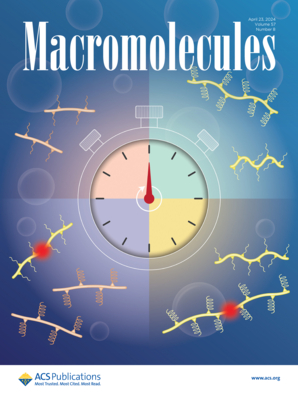In Situ Formation of Tröger’s Base-Derived Porous Organic Polymer Membranes with Greatly Enhanced Ultramicroporosity and Gas Separation Property
IF 5.1
1区 化学
Q1 POLYMER SCIENCE
引用次数: 0
Abstract
Formation of porous organic polymer (POP) membranes is a great challenge due to their highly cross-linked nature that prevents film formability. Here, we reported a series of mechanically strong POP membranes derived from a cross-linked Tröger’s base using 3,3′-dimethylbiphenyl-4,4′-diamine as a linear monomer and 1,3,5-tris(4-aminophenyl)benzene (TPB) as a cross-linking node. As the TPB content increased from 0% (TPB-0) to 75% (TPB-75), these POP membranes show a continuously decreased chain spacing from 7.96 to 6.22 Å, increased Brunauer–Emmet–Teller surface areas from 250 to 531 m2 g–1, and enhanced ultramicropore volumes from 0.046 to 0.143 cm3. Thereby, a huge increase in permeability without sacrificing selectivity was observed for these TPB-based POP membranes. For example, TPB-75 exhibited not only over 19 times larger O2 permeability (790 vs 50.3 Barrer) but also slightly higher O2/N2 selectivity (4.8 vs 4.5) than the linear TPB-0. The overall separation performances quickly improved from below the 2008 trade-off curves for TPB-0 to near the latest 2015 curves for O2/N2, H2/N2, and H2/CH4 as the TPB content increased. These results are attributed to the significantly improved ultramicroporosity that enhanced the molecular sieving effect by the POP structure induced by in situ cross-linking. This design protocol and the POP membranes provide a novel direction for advanced gas separation membranes.

求助全文
约1分钟内获得全文
求助全文
来源期刊

Macromolecules
工程技术-高分子科学
CiteScore
9.30
自引率
16.40%
发文量
942
审稿时长
2 months
期刊介绍:
Macromolecules publishes original, fundamental, and impactful research on all aspects of polymer science. Topics of interest include synthesis (e.g., controlled polymerizations, polymerization catalysis, post polymerization modification, new monomer structures and polymer architectures, and polymerization mechanisms/kinetics analysis); phase behavior, thermodynamics, dynamic, and ordering/disordering phenomena (e.g., self-assembly, gelation, crystallization, solution/melt/solid-state characteristics); structure and properties (e.g., mechanical and rheological properties, surface/interfacial characteristics, electronic and transport properties); new state of the art characterization (e.g., spectroscopy, scattering, microscopy, rheology), simulation (e.g., Monte Carlo, molecular dynamics, multi-scale/coarse-grained modeling), and theoretical methods. Renewable/sustainable polymers, polymer networks, responsive polymers, electro-, magneto- and opto-active macromolecules, inorganic polymers, charge-transporting polymers (ion-containing, semiconducting, and conducting), nanostructured polymers, and polymer composites are also of interest. Typical papers published in Macromolecules showcase important and innovative concepts, experimental methods/observations, and theoretical/computational approaches that demonstrate a fundamental advance in the understanding of polymers.
 求助内容:
求助内容: 应助结果提醒方式:
应助结果提醒方式:


